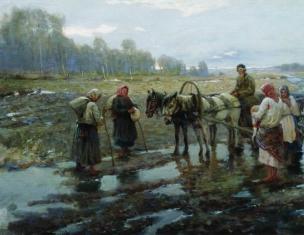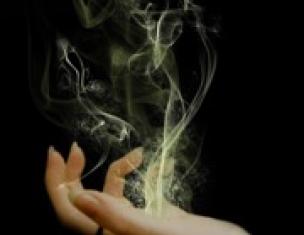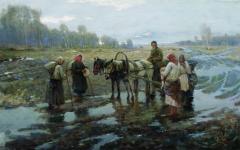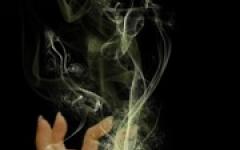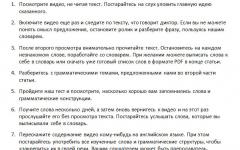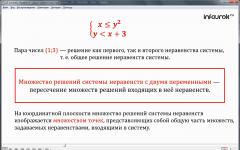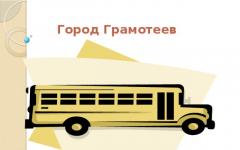Reading lesson in the 5th special (correctional) class of VIII type on the topic N. Nosov “The Blot”
Goal: to introduce children to the works of N. Nosov and his story “The Blob”
Educational: improve fluency skills expressive reading, reading techniques, learn to justify your answer, be able to navigate the text.
Correctional and developmental tasks: to develop creative imagination, speech, attention, memory of students.
Educational: to cultivate neatness, the ability to behave at recess and during lessons, and respectful attitude towards others.
Equipment: chalk, board, syllable table, masks, portrait, book exhibition.
Plan
I.Organizational start of the lesson
II.Dynamic warm-up
III.Preparation for primary perception
A) conversation on issues
B) working with a column of words
IV.Primary perception. Conversation on first impressions.
V.Re-reading the story and analyzing it
a) reading part I
b) reading part II
V) reading III parts
d) reading part IV
Making a plan
VI. “Catch-up”
VII. General conversation
IX. Assessment
Lesson progress
I.Organizational beginning
II.Dynamic warm-up
1. Breathing exercise “Alphabet”
Slowly
2. Exercise to practice diction
a) Reading syllables taking into account increasing difficulties in pronunciation
mzdo zvo sleep
take revenge
tdal ctor izhski
inadvertently inadvertently
lenbisch takeoff pmsk
strictly guest jet
nonsense discord flattery
b) working on a tongue twister
Forty mice walked, carrying forty pennies,
Two smaller mice carried two pennies each.
What does flatter mean? (worse)
We read in rows:
Slowly
A little faster
3. exercises to practice expressive reading.
Sa-sa-sa-sa
Bitten on the nose by a wasp
So-so-so-so
My nose became like a wheel.
Read as the mask shows


III. Preparation for initial perception
a) conversation on issues
What story did you learn about in the last lesson? (“Gardeners”)
Look at his portrait.
What other stories by N. Nosov do you know?
Guys, what kind of stories does N. Nosov write? (Funny, instructive, educational)
That’s right, what qualities do these stories foster in a person? (honesty, courage, camaraderie, persistence in achieving goals)
b) Work on the meaning of words
Read the columns of words
Hurry-mix
Confused and scared
Understand-raise
Lower-release
He bragged and grabbed
Explain the meaning of these words.
How are the words different? (one or two letters)
Do the meanings of words differ? (Yes)
Let's explain the meaning of each pair of words.
Hurry - (hurry)
Laugh - (make someone laugh)
Mixed up - (mixed up, did something else instead of one)
Scared - (scared of something)
Lower - (move down, for example, a bucket into a well)
Let go - (Allow someone to leave, for example, a child on the street)
Grabbed - (grabbed the railing, handle)
Boasted - (boasted)
IV. Primary perception of the story. Conversation on first impressions.
Today we will get acquainted with another story by N. Nosov “The Blob”
What do you think this story is about? (...)
Reading by teacher
Question for row 1
- Determine what kind of story this is by nature - serious, funny, sad, joyful?
- Why?
- Did you like the story?
V. Re-reading the story and analyzing it
a) Reading 1 - oh part (buzz reading)
What habit did Fedya Rybkin have? (Make the guys laugh)
How did Fedya get a black blotch on his forehead? (Fedya got into a fight with Grisha over a bottle of mascara. When they tore the bottle out of each other’s hands, the mascara splashed out and one drop hit Fedya’s forehead)
What do the words “bottle of mascara” mean? (Black or colored paint in a specially prepared bottle for drawing, drawing and writing)
How did Fedya react to this? (At first he got angry, and then he saw that all the guys were laughing at him and did not wash off the blot)
How can you title this part? Highlight main idea.("A drop hit my forehead")
Let's write down the first point of the plan
b) Reading part 2 (in chain)
How did the guys behave when they saw Fedya? (They looked back at him and laughed at the blot)
What did Fedya do? (I deliberately smeared my nose with mascara)
Why did he do this? (He liked that all the guys laughed when they looked at him, he liked to make the guys laugh)
How Zinaida Ivanovna behaved, find it in the text and read it.
How do you understand the words “broken” (Sad)
How did Fedya react to Zinaida Ivanovna’s words? (At first I got worried, then I got scared)
Why was Fedya scared? Read it.
Highlight the main idea.
What should we title this part? (“Fedya got scared”)
Let's write down the plan item in a notebook.
c) Reading part 3 (by roles)
Guys, look at the illustration, which part does it go to?
Who is depicted on it? What are they doing?
Let's read this part by role.
What mood should Fedya be in? How should you read? (scared)
What can you say about Grisha? (He's trying to help)
Find action words that describe Fedya's behavior.
What did Fedya decide to do? (He decided to run to wash himself)
How did Zinaida Ivanovna react to Fedya’s requests? (She didn't let him in0
Can we say that Zinaida Ivanovna treated Fedya cruelly? (no, because she decided to teach him a lesson)
Find words that describe Fedya's condition. (He whined and now he had no time to laugh)
Read Zinaida Ivanovna's answer
What is the main thing in this part?
What should we title part 3? (“Fedya sat on pins and needles”)
d) Reading part IV (to yourself)
What happened when the bell rang? (Fedya ran to the washroom and spent the entire recess rubbing his face with soap)
Why did he do this? (He was afraid that sores would appear on his face)
What was the whole class doing at this time? (Made fun of Fedya)
Did the class do well or poorly? (It’s bad, because Fedya was scared and it was hard for him. The guys should have helped Fedya, and not laugh at him.)
How did Fedya change after this?
How can you title this part? What's the main thing here? (“Fedya has forgotten how to laugh”)
VI. "Catch-up"
Now let's play the game "Catch-up". I start reading a sentence, and you finish it.
VII. Summary conversation
What is the main thing in the story? (That Zinaida Ivanovna taught Fedya a lesson, and now he has become serious and no longer laughs in class)
Find a passage that expresses the main idea. (Let it itch....)
VIII. Lesson summary
What work did you learn about in class today?
What do you remember most?
IX. Homework
Retelling according to plan
Sections: Primary school
Goals:
- Continue your acquaintance with the works of N.N. Nosov.
- Development of memory, interest in reading, creative abilities of students.
- Develop the ability to analyze and evaluate the actions of heroes, relate them to one’s own life experience.
- To develop students’ speech by teaching them how to construct their own statements, creativity in predicting the content of the text.
- To develop the ability to control one’s activities and evaluate them based on objective indicators of knowledge.
- Bring up moral qualities.
Equipment: exhibition of the writer's books, list of achievements, assignments, drawings.
Achievements list
Student(s)F.I.______________________________
Lesson progress
1. Organizational moment.
Hello guys!
Hello, dear guests!
Let's smile at each other, and smiles will make us all feel more comfortable and warmer!
It even became brighter in the classroom.
IN good mood Let's get to work.
2. Introduction to the lesson plan.
1. Class organization.
2. Checking homework.
3. Work on new material.
A) topic and goals.
B) vocabulary work.
B) "master of words"
4. Physical exercise.
5. Analysis of the work.
6. Homework.
7. Summing up.
I wish you fruitful work.
3. Checking homework.
What story did we learn about in the last lesson?
"Gardeners" by N.N. Nosov. frame No. 1 ( Presentation)
Do you know the content well? Let's check. (The children have leaves on their desks with 1 task:
1) Place the points of the plan in order.
1. Let's compete!
2. Getting started
3. “When there is no agreement among comrades:”
4. Cunning plan
5. "Oh, we are donkeys!"
6. We were taken in tow.
7. We still got the red banner.
(exchanged pieces of paper and checked their neighbor on the desk by comparing with the model on the board)
Evaluate yourself.
No errors +
Mistakes were made -
What was the creative task?
Each group demonstrates a fragment of the filmstrip, accompanied by reading the text.
2) “Demonstration” of the film strip “Gardeners”
Forward!
(children show a drawing and read an excerpt from the work) group 4 people - 1 with a drawing, 3 people. read by role).
Well done!
4. Preparing students for active and conscious learning of new material.
Read the notes to yourself from the notes on the cards. frame number 2.
What do they have in common?
These are the titles of stories by N.N. Nosov. These are fun, funny stories.
Yes, this is not the first lesson we have been studying (reading) the works of N. Nosov.
What do you know about this writer? What kind of person was he?
1) Testing knowledge of the writer’s biography:
On sheets of paper green text (biography of the writer) leave only reliable facts, cross out what is unnecessary.
(One person is at the board. He selects cards with the words necessary to fill in the missing words). frame number 3.
Let's check. Let's evaluate ourselves.
Who has this?
Put +, no -.
Conclusion: well done, you know the writer’s biography well.
What is characteristic of the works of N.N. Nosov?
They are short, funny, and clearly constructed.
This is how another wonderful writer Valentin Kataev speaks about N.N. Nosov. frame number 4.
2) Communicating the topic and goals of the material being studied.
What work will we learn about in class today?
Read starting from capital letters. frame number 5.
What is a blot?
A blot is a stain caused by ink dripping from a pen.
In class literary reading what are we learning?
What are the objectives of today's lesson?
- Get acquainted with the work.
- Reveal the author's intention.
- Learn to read correctly (fluently, without errors, expressively).
The main question of the lesson?
What is the idea of the work? (written on the board)
3) Vocabulary work.
Purpose: At this stage we will talk about the meaning of some words that appear in the text. For what purpose do you think we will do this?
To understand the meaning of these words, enrich your vocabulary, and more accurately understand the meaning of the work.
The work will contain: words. If we cannot explain them, the interpreter will be: (Khadarovskaya Christina).
- bottle
- blisters
- lichen
- sores
- corrodes
- eraser
- amuse
Conclusion: We figured out the words. Well done.
4) Exercises to develop reading skills.
To avoid mistakes when reading, let's practice reading these words.
- Hurry - make you laugh
- Confused - scared
- Understand - raise
- Lower - let go
- Grabbed - boasted
- Rang - rang
(Who's ready for "house")
2) Exercises for the eyes.
Blink. Close your eyes tightly, then open them wide.
5. Familiarity with the text of the work. (master of words, People's Artist of the USSR Lev Durov - 5-minute recording). Analysis of a work (artistic image).
It's time to find out what this work is about.
Listen carefully to the master of words, People's Artist of the USSR Lev Durov.
Purpose: what genre do we classify the work into? Who main character? Follow the text, watch the intonation.
(listening for 5 minutes)
Did you like the piece? How?
Is your personality serious or funny, sad or joyful?
What genre does this work belong to?
Meets all the characteristics of the story.
Small volume, description of one episode, few characters.
Who is the main character of this work?
Fedya Rybkin. This hero has a set of certain character qualities.
But the text never directly mentions it.
Try now to identify the qualities that Fedya possesses.
Check +. (yellow leaves)
- Cruel
- Mischievous
- Selfish
- Vicious
- Funny
- Playful
- Hardworking
- Restless
- Prudent
- Sincere
- Responsible
We will know whether you are right or wrong when we find in the text those sentences and passages that help us learn about the character qualities of the hero.
How does the main character of the story appear to readers at the beginning of the work?
": He had a habit of making the whole class laugh: is it recess now or is it a lesson"
So what is he like?
Confirm with a description of his action:
"Fedya really liked the mascara on her nose"
antics
playful
How did Zinaida Ivanovna react to Fedya’s trick?
She was surprised. She told me what danger awaits Fedya.
Why did the teacher behave this way? Your opinion.
She wanted to tell the naughty boy a lesson, but so that he himself would understand his mistake.
Has Fedya changed after this whole story? What made him change?
"Fedya was scared: he stammered."
Read the passage that matches the illustration.
": Fedya started again: it didn’t help."
restless
sincere
Evaluate yourself.
No errors +
Mistakes were made -
What conclusions did Fedya make for himself?
": this week Fedya: and that’s not always the case"
Your attitude towards the hero at the beginning of the work.
With his behavior, he interfered with the rest of the children's studies. Disturbed the teacher. This is bad. After all, people come to school to gain knowledge, not to disrupt lessons, not to misbehave.
Your attitude towards the hero at the end of the story.
Well done, he understood and corrected himself.
Did you empathize with the hero?
The writer talks wittily and cheerfully about Fyodor Rybkin. The most ordinary life events turn into stories by N.N. Nosov in unusually funny instructive stories. The writer does not obsessively, without “adult moralizing,” shows the meaninglessness and absurdity of bad actions. He describes the anxiety and excitement experienced by a small schoolboy who has committed an unseemly act. Readers empathize with the characters because they themselves could find themselves in such situations.
Let's remember our main question lesson. To more accurately express your thoughts, use proverbs. (frame No. 6.) (frame No. 7).
Match the proverbs with the main idea of the story.
Underline those statements that reflect the main idea of the work. (pink leaves)
Justify your answer.
- Some learn from the experiences of others, and others from their mistakes.
- Know how to make a mistake, know how to get better.
- Patience and work will grind everything down.
- If you hurry, you will make people laugh.
Evaluate yourself.
No errors +
Mistakes were made -
Have we answered the main question of the lesson?
7. Reflection.
Was the lesson interesting? (according to the table using signal circles)
Evaluating our working together(use the evaluation table), I see that we have well-developed skills::::::, we need to work on developing:::.
8. Homework.
At home you will complete tasks related to the study of the work in class, and everyone will choose a task that is within their capabilities.
3)* Staging a small play based on this story.
You will succeed.
Blot
Summary story
The boy Fedya Rybkin loved to make the whole class laugh, it was even a habit. Once he got into a fight with Grisha Kopeikin over a bottle of mascara. And accidentally one drop fell on Fedya’s forehead. At first he was angry, but when he saw that all the guys were laughing, he decided that this blot on his forehead was even for the better.
The lesson began, and Fedya deliberately smeared himself even more with mascara. The guys roared with laughter. When the teacher noticed what Fedya had done, she told him that the mascara was chemical, poisonous, and would cause blisters and sores. Fedya got scared
And throughout the lesson I rubbed my face with either a blotter or a handkerchief, but nothing helped. He got scared and raised his hand to go out to wash, but the teacher did not let him go. Fedya already began to feel that her face was starting to itch, but the teacher said: “Nothing. Let it itch. But next time you won’t smear your face with anything.”
Fedya sat as if on pins and needles and kept clutching his face. During recess, Fedya ran to wash his face. I spent the entire recess rubbing my face with soap. Then Fedya walked around gravely all week: he kept expecting blisters to appear on his face. But the blisters never popped up, and during this week Fedya even forgot how to laugh in class. Now he laughs only during breaks, and even then not always.
In this story, the main character was schoolboy Fedya. The boy loved to amuse his classmates, and especially preferred to do this in class.
One day he got into a fight with a peer over a bottle of mascara. In the midst of the brawl, paint splashed out of the bottle and a small blot the size of a coin appeared on Fedya’s forehead. The boy was confused at first, but then he saw that the guys were laughing incessantly at his funny face. “That’s great!” - thought the boy and not only did not wash the stain, but also smeared the blot all over his face.
The lesson has begun. The teacher entered the class and noticed an incomprehensible excitement reigning among the children. Looking around, I saw a grimy and proud merry fellow behind his desk.
The experienced woman immediately appreciated what was happening, but did not show it. She sternly asked the student what happened. Fedya looked contentedly, looking back at the children dying of laughter, and pointed to the bottle. But it turned out, according to the teacher, that this mascara was harmful to the skin, so he would soon develop blisters and sores on his face.
The boy was terribly scared and began to wipe his face with everything he had at hand, nothing helped. Then he decided to wash himself with soap and water, but the teacher did not let the child go during the lesson.
Fedya washed himself only after finishing all the lessons. Nothing, of course, appeared on his face, but from then on he lost the desire to have fun in class.
Picture or drawing Blob
Other retellings and reviews for the reader's diary
- Summary of Schwartz The Tale of Lost Time
The Tale of Lost Time by Evgeniy Schwartz tells how precious time is and how easily we waste it. The main character is third-grader Petya Zubov.
- Summary of Burgess A Clockwork Orange
If I were to compile a list of required reading in schools, Anthony Burgess's A Clockwork Orange would be on it, without any doubt. The product is very tough
- Summary of the opera Iolanta
The opera begins with a scene in a beautiful garden in the mountains. There the princess, who doesn’t even know that she is the king’s daughter, is sad. She is young and beautiful, her age is characterized by doubts and worries
- Summary of Hobbes Leviathan
An essay on political theory, it is often called the book of transition from medieval ideology to modern political thought. This is the basis for the formation of the liberal ideological paradigm.
- Summary of Zakhar Berkut Franko
The events take place in the Carpathian village of Tukhlya, whose residents live freely and do not depend on anyone. There is no power over them, and the people live together. Boyar Tugar Volk comes to this village
LESSON SUMMARY in 4th grade
Subject: Literary reading Subject: Reading and Comprehension LessonstoryN. Nosova “Blot”.(Author of the textbook “Favorite Pages” O.V. Kubasova ) Lesson type: A lesson in “discovering” new knowledge Planned results. Personal results:- allow the existence of other points of view, listen to the interlocutor, do not interrupt, express your point of view calmly. know about the rules school life, consciously apply them in literary reading lessons, justify their existence and benefits for the student. build a moral and ethical judgment from 2-3 sentences based on moral concepts and norms about the actions of one or another character in the work. to form an anti-corruption worldview, cultivating such moral qualities as duty, responsibility and justice.
- together with the teacher, formulate the educational task of the lesson in accordance with the goals of the topic; accept the learning task of the lesson.
identify known knowledge and skills from the topic of the lesson, determine the range of unknowns on the topic being studied
give self-esteem.
express your thoughts verbally and writing taking into account their educational and life speech situations.
participate in dialogue; listen and understand others, express your point of view on events and actions;
argue your point of view in the process of reflecting on the actions of literary heroes, evaluate the hero’s actions.- use methods of analysis and synthesis when studying short literary texts based on the teacher’s questions; Understand the figurative meaning of a figurative word, phrase or sentence, interpret them; analyze the motive of the hero’s behavior using questions.
- independently determine the theme of the work; under the guidance of the teacher, determine the main idea of the work;
development of artistic creativity;
characterize the hero of the work under the guidance of a teacher (who is he? what is he like?);
2. Preparation for the initial perception of the text. Setting the lesson goal. Look at the book exhibitionGuess which author's work we will study today. Yes, also N. Nosova. But among the books there is an “extra” book. Find her (book by E. Nosov).A few words about the writer
 Take a closer look at the portrait of the writer. How does he appear to you? What works did Nosov write, in what genre? (stories). On what topic? (0 children).Rebus
Take a closer look at the portrait of the writer. How does he appear to you? What works did Nosov write, in what genre? (stories). On what topic? (0 children).Rebus
 Look at the slide. Guess the title of the story we will read today:(After guessing, the cover of the book appears on the board.)Working with the word.
What does the word "blot" mean? (Children’s answers.) In S.I. Ozhegov’s dictionary you can find the answer: “An ink stain on paper”
Look at the slide. Guess the title of the story we will read today:(After guessing, the cover of the book appears on the board.)Working with the word.
What does the word "blot" mean? (Children’s answers.) In S.I. Ozhegov’s dictionary you can find the answer: “An ink stain on paper” Do you think this is modern word or outdated? Whoever works well in class will have the opportunity to write a real ink after the lesson.We will meet words again
Do you think this is modern word or outdated? Whoever works well in class will have the opportunity to write a real ink after the lesson.We will meet words again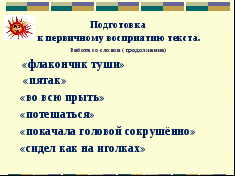 “a bottle of mascara” (a bottle of paint); “pyatak” (5 kopeck coin); “at full speed” (very quickly); “to laugh” (laugh not out of malice), “shook her head sadly” (sadly), “sat on pins and needles” (restless).
“a bottle of mascara” (a bottle of paint); “pyatak” (5 kopeck coin); “at full speed” (very quickly); “to laugh” (laugh not out of malice), “shook her head sadly” (sadly), “sat on pins and needles” (restless).3.Primary perception of the text, checking primary perception. (Chain reading).How is this story similar to the previous one?
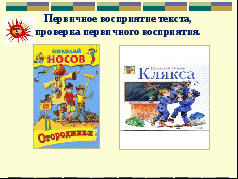 (it’s about children; children find themselves in unusual situations, funny and sad at the same time; the texts are instructive).
(it’s about children; children find themselves in unusual situations, funny and sad at the same time; the texts are instructive).Dynamic pause (Stand on tiptoe, like Fedya, as many times as there are syllables in the words Fedya, Grigory, Zinaida.)
4.Analysis of a literary work. Open the dictionary of moods. Determine what kind of story this story is based on its mood? (serious and sad, funny, joyful). Find words from the text that support this. Drawing up portraits of the main characters
 How does the main character of the story, Fedya Rybkin, appear to the readers at the beginning of the story? (read out).How has Fedya changed at the end of the story? (read out).What feelings did Fedya experience during this story? (The necessary words are written on the board).Do you think Fedya can be called a naughty boy or a hooligan? Why?What made Fedya change?Why did Zinaida Ivanovna behave this way?What kind of Zinaida Ivanovna do you imagine? (wise, fair).Do you think the teacher is right in her attitude towards the boy? (Prove it).From whose perspective is the story being told? (on behalf of a boy, a student in this class).What can you say about Fedya's friend? (supported, offered a rubber band...)Find a proverb that fits the relationship between two friends
How does the main character of the story, Fedya Rybkin, appear to the readers at the beginning of the story? (read out).How has Fedya changed at the end of the story? (read out).What feelings did Fedya experience during this story? (The necessary words are written on the board).Do you think Fedya can be called a naughty boy or a hooligan? Why?What made Fedya change?Why did Zinaida Ivanovna behave this way?What kind of Zinaida Ivanovna do you imagine? (wise, fair).Do you think the teacher is right in her attitude towards the boy? (Prove it).From whose perspective is the story being told? (on behalf of a boy, a student in this class).What can you say about Fedya's friend? (supported, offered a rubber band...)Find a proverb that fits the relationship between two friends (“Not for service, but for friendship”). Explain its meaning.Find a picture for the text and a passage that matches this proverb.
(“Not for service, but for friendship”). Explain its meaning.Find a picture for the text and a passage that matches this proverb.Visual pause
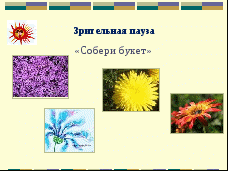 (“Pick up a bouquet”: give flowers to Zinaida Ivanovna. With our eyes we find a yellow flower, a blue one, a green one above the board...)
(“Pick up a bouquet”: give flowers to Zinaida Ivanovna. With our eyes we find a yellow flower, a blue one, a green one above the board...)5. Generalization of the analysis results. Reading by roles. How will we read: loudly or quietly? Why (Quiet, because there is a lesson in progress).In what tone will we read for Fedya? (anxious, restless).For Grisha? (preoccupied, businesslike) Lesson summary. What did the author want to teach us? (So that we do everything on time: study in class, have fun during breaks, take a responsible approach to the work we do). Which proverb fits this story? (“Business time – time for fun”)
 Creative task.
On the given pieces of paper, draw a blot and write a wish to Fedya (to the music).Draw it in such a way that it “comes to life”. What is this called? literary device? (personification). What other literary device do you know? (comparison). Compare the blot, what does it look like? (on a cloud, puddle...)What do the blots on the slide look like?
Creative task.
On the given pieces of paper, draw a blot and write a wish to Fedya (to the music).Draw it in such a way that it “comes to life”. What is this called? literary device? (personification). What other literary device do you know? (comparison). Compare the blot, what does it look like? (on a cloud, puddle...)What do the blots on the slide look like? Remember in which fairy tale one careless student put an ink in his notebook? (on the board is an illustration for the fairy tale “The Adventures of Pinocchio”)
Remember in which fairy tale one careless student put an ink in his notebook? (on the board is an illustration for the fairy tale “The Adventures of Pinocchio”) Self-assessment
using red, green and yellow cards.Homework
.
Reading by roles; imagine yourself as the author and think about what you would change in the story.
Self-assessment
using red, green and yellow cards.Homework
.
Reading by roles; imagine yourself as the author and think about what you would change in the story. Don't waste your time -
Read Nosov's books!
Don't waste your time -
Read Nosov's books!
After the lesson, the children put blots on pieces of paper and share with each other their opinions on what they look like.


